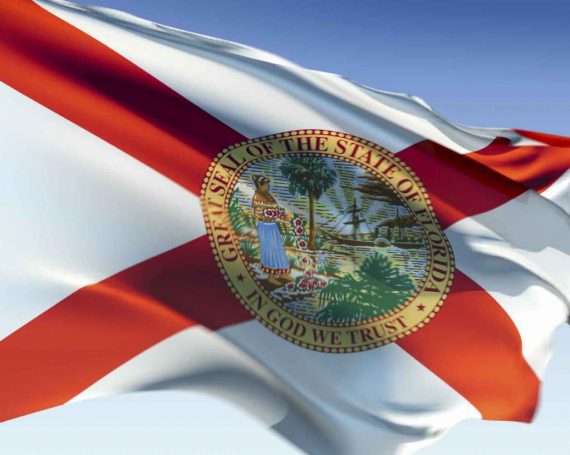Florida Will Soon Pass New York In Population
The Sunbelt continues to dominate.
New York State, once the most populous state in the nation, ceded that position to California many years ago, and slipped behind Texas not long after that, now it looks like it will slip into fourth place as early as next year:
ALBANY — New York, whose status as the most populous state has long been ceded, will soon fall behind Florida into fourth place, a long-anticipated drop that is rife with symbolism and that could carry potentially serious economic consequences in coming years.
When the Census Bureau releases its latest population estimates on Monday, demographers expect that Florida and New York will be narrowly separated — perhaps by as little as a few thousand people — and that if Florida does not pass New York this time, it almost certainly will do so in 2014.
The census figures underscore immigration trends, as foreign-born migrants continue to move to warm-weather states such as California and Texas — No. 1 and 2 — as well as to Florida. The newcomers also include winter-weary New Yorkers who move or retire to Florida at a rate of over 50,000 a year, twice the number of Floridians who head to New York.
But the shift also highlights the struggles in upstate New York, which has lost large-scale manufacturing jobs and large chunks of population, offsetting consistent gains in New York City. But the city’s growth has seemingly not been robust enough to stave off hubs in Florida like Jacksonville, Miami-Dade County and Tampa.
“It’s going to happen,” said Andrew A. Beveridge, a professor of sociology at Queens College and an expert on the census, on New York’s falling into fourth place. “And if Florida accidentally grew faster and New York slowed down, it could have happened already.”
Beyond a blow to New Yorkers’ collective ego, the changing population pattern could have many practical and political implications, including diminished congressional delegations, a setback New York already suffered in 2010 — the year of the last decennial census count — when the state lost two districts, while Florida gained two seats. Census data also inform how billions of dollars in federal funding and grants are divvied up among the states, for things like highway planning and construction, public aid for housing and health care and education programs.
All of which has Florida feeling good.
“Every number we see, if we don’t pass them this year, we’re going to pass them in the next few months,” Gov. Rick Scott of Florida, a Republican, said in an interview last week. “Florida’s on a roll.”
A closer look at the numbers shows that New York is not actually losing population. It has been growing at about 1 percent annually of late, but it simply cannot keep up with Florida’s rate of growth, which was about 2.7 percent between April 2010 and mid-2012, according to the Census Bureau. However, New York’s population is declining in upstate cities like Buffalo, which has lost more than 10 percent of its population since 2000, as well as places like Syracuse and Rochester, where population is largely stagnant.
New York Governor Andrew Cuomo has spent the last year or so trying to reverse this trend, principally by getting the legislature to create special tax breaks for people who establish businesses in Upstate New York, especially in areas like Syracuse, Rochester, and Buffalo. Indeed, I’ve seen commercials narrated by Cuomo showing up on television down here in Northern Virginia. How persuasive this program will actually get in persuading in employers, and Cuomo undoubtedly hopes potential employees to move to the Empire State remains to be seen, but its success is likely to be a major part of any measure of his success in office either as a Presidential or Vice-Presidential contender in the future. The problem, though, is that even the promise of tax breaks may not be enough to persuade people to move to New York as opposed to Florida, Texas, Virginia, or the Carolinas. With all due respect to my friends in Upstate New York, it’s hard to see many people choosing Buffalo over Tallahassee or Orlando, just to pick one example.
Additionally, notwithstanding the tax benefits that Cuomo is offering businesses who meet certain conditions, there are plenty of other economic reasons why moving to New York isn’t going to be appealing either to businesses or individuals. Tax rates for individuals are far higher in New York than they are in Florida, for example, even in places where the upstate areas, where the cost of living is far lower than the areas in and around New York City. Employers may find it hard to recruit the right kind of people for the jobs they need even though Governor Cuomo’s program seems to be based around trying to get businesses to move to areas close to locations of campuses of the State University of New York, obviously on the theory that these schools would provide a good recruitment class for high-tech industries most especially. Finally, of course, there’s the question of just how much they can trust that future state legislatures or Governor’s won’t find it necessary to take away those tax breaks that are supposed to last ten years, or require businesses to certain regulations in order to continue receiving them. When faced with those issues on one side of the ledger, and the possibility of starting a business in a state like Florida that has a long history of favorable tax rates and a political culture that makes it unlikely that there will be massive tax increases in the near future, it’s easy to see why businesses might be skeptical about making the long trek to Rochester or Buffalo.
All of this, of course, is simply just another example of the rise of the Sunbelt. Rather than migration from the north, what we’re seeing here is people who are willing to move to another state, or new immigrants to the country, choosing warmer climate states to colder climate states. It’s been happening to the Rustbelt and the Northeast for decades now, and it’s likely to continue for quite some time into the future.
The good news for New York is that a move down one spot to 4th place isn’t likely the beginning of a trend. The states immediately below it — Illinois, Pennsylvania, and Ohio — are all pretty far behind and they are all falling behind in the population race themselves.
Update: Jazz Shaw, who lives in Upstate New York has some thoughts of his own:
Doug also cites the weather, as does the previous New York Times article. Personally, while many people find the climate in the South appealing, I think it’s far from enough to cause this sort of shift. The state government wrings its hands over the loss of jobs, but continues to keep a moratorium on fracking, which has benefited our neighbors in Pennsylvania greatly. Stimulus plans to attract business such as the ones Doug describes sound great on paper, but do nothing to address the hoards of businesses who have already left one of the unfriendliest tax climates in the nation. Nanny state regulations make New York one of the least free in the nation and many upstate folks have simply tired of it.
The punishment for these policies will not be imposed by Washington or outside think tanks. It’s taking place before our eyes, and as people leave, the welfare rolls and unemployment lines swell and our congressional representation in Congress continues to shrink.
Jazz does make a good point about the weather. Personally, I wouldn’t find the weather in Florida, or Texas, all that appealing, at least not all year round. Indeed, were I to move South, I doubt I’d look at anything south of South Carolina. At the same time, it’s worth noting that much of the factors that most of the factors that the original article cites as contributing to Florida surpassing New York don’t consist of New York losing population so much as it is Florida gaining population at a faster rate, particularly due to immigration. Given that the principal sources of immigration into the United States today are coming from areas to the south of Florida, it seems only natural that those immigrants would prefer a climate somewhat similar to the one that they came from. Nonetheless, Jazz is correct about the general status of the business climate in New York, particularly when it comes to issues like fracking. Indeed, it is worth noting that the one state in the nation now experiencing the greatest economic boom is North Dakota of all places which has become the center of an energy boom due to both fracking and oil exploration. Indeed, the unemployment rate in that state is the lowest in the country. All of this despite a climate that can be particularly harsh during the fall, winter, and even early spring. If that isn’t proof of the idea that a friendly climate for business and jobs will drive people to invest, I don’t know what is.





It’s easy to choose Orlando over Buffalo in January. In July, on the other hand…
Cuomo would have been better off trying to increase the speed and scale of housing construction and ease of business in the New York City metro area. It would be much more of a major draw for people to move there if they could afford the housing.
Relying on the college campuses is a good idea, because that’s not something that businesses are going to just up and abandon for marginally lower taxes in Texas.
@Pinky
I remember going to one of the Universal Studios theme parks in mid-July ten years ago. It was something like 95 degrees, 80-90% humidity – total steam bath, although not as bad as when I went to see a Shuttle launch.
I don’t understand why people have such a tolerance for humid heat, even with air conditioning. You sweat like crazy, nothing ever dries outside, and so forth.
@Doug Mataconis
I think the housing cost differential and Latino population concentration in the Southwest matter the most in this trend. There was not only tons of movement between states, but also tons within states, all towards areas with much cheaper housing costs than what you find in the successful old cities like San Francisco and New York City.
Similarly, if you look at a map of Latino concentrations of population, it’s heavily, heavily concentrated in the Southwest with a few pockets in major cities and places like southern Florida (such as the Puerto Rican community in NYC and the Cuban-Americans in south Florida respectively).
Man, I just don’t get this sunbelt thing. I must not be human, because warmth and sunshine are mostly a pain in the ass to me. Give me winter! Give me rain!
I think it’s inhumane that we let people live in Florida at all.
@Brett: You get used to it. Your blood thins out. Not really. Afternoon thunderstorms help.
This kind of thing never works. We’ve seen it over and over again. Business moves in for special breaks, leaves when the breaks expire. If you want to revive an economy, make the conditions good for *everyone*: reasonable taxes and regulation, educated work force, good infrastructure.
First, most of Florida’s population doesn’t live in Orlando, it lives near the coast where the ocean moderates the humidity. Second, Florida doesn’t have the high humidity of the interior South.
Winter is very hard on the global warming. And coastal Mississippi gets more rain than Seattle. They just get it in 15 minute bursts over the month of July and August.
New York State’s GDP per capita: $57,423.00
Florida’s GDP per capita: $40,106.00
OTOH, Florida will be a bunch of islands in 50 years thanks to the rise in sea level caused by global warming.
There is only one New York. There are DOZENS of places all over the world that also have humidity, beaches and strip malls, but with better beaches and with more nicer people.Besides that, the risk that you´ll find a complete loser with gun playing cop is something that you´ll only find in Florida.
I look forward to an increase in Florida Man stories, such as “Florida Man bites police car, causes $600 damage”
I love Florida. It reaffirms my comparative faith in the rest of the world.
@Andre Kenji:
Dozens? Thousands.
@Brett:
Similarly, if you look at a map of Latino concentrations of population, it’s heavily, heavily concentrated in the Southwest with a few pockets in major cities and places like southern Florida (such as the Puerto Rican community in NYC and the Cuban-Americans in south Florida respectively).
In recent years many of the New York Puerto Ricans have been moving to Florida, especially the Orlando area. At the same time, however, New York has been getting a big Mexican influx.
This native Floridian looks forward to the day when I can leave Florida once and for all. I look forward to moving up to the South.
Funny part is that when the humidity rises and beaches vanish, Floridans will still dismiss global climate change whilst demanding more subsidies from Northern states like NY.
@Stonetools: I seriously doubt that Southern Florida has that long.
There’s a really easy way to know a bad place to live.
Go to the local Home Depot or Lowes and see if they have snow blowers.
If they sell them, leave.
@Andre Kenji: research, it’s only a few clicks away!